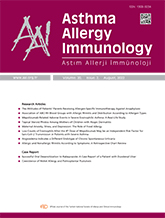


Objective: ABO antigens on the erythrocyte surface are known to be abundantly expressed in the digestive and respiratory tract. ABO antigens have been shown to be associated with certain diseases. Some studies have investigated the relationship of atopic diseases with blood groups. The aims of our study were to evaluate the relationship of ABO and Rhesus blood groups with allergic rhinitis and to determine the blood group distribution according to allergen types.
Materials and Methods: The study included 750 adult patients with allergic rhinitis and 750 blood donors. According to the skin prick test results, the patients were classified into three groups: patients with allergy to pollen, patients with allergy to house dust mite, and patients with allergy to pollen with house dust mite. The ABO Rh blood group was determined by the DiaClon ABO/D+Reverse Grouping (BIO-RAD) ID-card method.
Results: The ABO phenotype was found in 42.8%, 16.1%, 32.7%, and 8.4%, respectively, of the A, B, O, and AB group patients and 40%, 18.8%, 33.86%, and 7.33%, respectively, in the control group. There was no difference in the distribution of ABO blood types and Rh factor. The frequency of allergy to pollen, house dust mite, and pollen with house dust mite in patients were 495 (66%), 81 (10.8%) and 174 (23.2%), respectively. There was no significant difference in the distribution of ABO blood types and Rh factor by allergen type.
Conclusion: Similar to the normal population, the A blood group was most common in patients with allergic rhinitis. There was no relationship between the ABO blood group and allergen types in patients with allergic rhinitis.